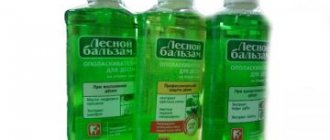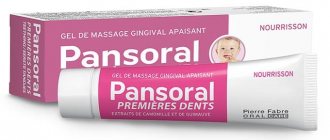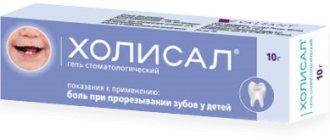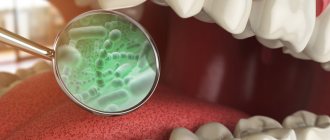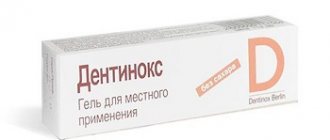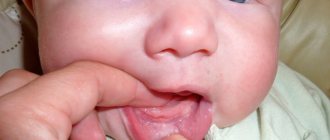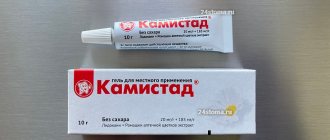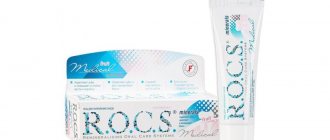Author of the article:
Soldatova Lyudmila Nikolaevna
Candidate of Medical Sciences, Professor of the Department of Clinical Dentistry of the St. Petersburg Medical and Social Institute, Chief Physician of the Alfa-Dent Dental Clinic, St. Petersburg
One of the most popular products in dentistry is the adhesive balm for gums "ASEPTA®". The use of this combination remedy is an excellent prevention of problems in the oral cavity. Let's try to figure out how and why to use this balm.
Content:
- Active substance
- Indications for use
- How to use it correctly
- Benefits of the medicine
- Contraindications
In the treatment of many dental diseases, doctors use local anti-inflammatory drugs.
They have an impact directly on the source of inflammation, thanks to which the doctor quickly gets positive results. The drug Asepta, made from the waste product of bees, is in particular demand in dental practice. It is produced by a Russian pharmaceutical company. In pharmacies, the product can be purchased in the form of a gel located inside a plastic tube. The kit includes a small spatula applicator for convenient use of the medicine.
Clinical researches
Repeated clinical studies have proven that using ASEPTA adhesive gum balm for a week can reduce gum bleeding by 51% and reduce inflammation by 50%.
Sources:
- The use of adhesive balm "Asepta®" in the treatment of inflammatory periodontal diseases L.Yu. OREKHOVA*, Dr. med. Sciences, Professor, Head of Department V.V. CHPP**, Dr. med. Sciences, Professor, Head of Department S.B. ULITOVSKY*, Dr. med. Sciences, Professor A.A. LEONTIEV*, dentist A.A. DOMORAD**, O.M. YAKOVLEV** SPbSMU named after. acad. I.P. Pavlova, St. Petersburg - *Department of Therapeutic Dentistry, **Department of Microbiology
- The effectiveness of the use of Asept “adhesive balm” and Asept “gel with propolis” in the treatment of chronic generalized periodontitis and gingivitis in the acute stage (Municipal Dental Clinic No. 4, Bryansk, Kaminskaya T. M. Head of the therapeutic department Kaminskaya Tatyana Mikhailovna MUZ City Dental Clinic No. 4, Bryansk
- Report on clinical trials of anti-inflammatory balm for gums "Asepta" adhesive, St. Petersburg State Medical University, 2007
Active substance
The official instructions indicate that the gum base contains only one active ingredient - propolis. As is known, it has antimicrobial, anti-inflammatory, analgesic and antipruritic properties, and exhibits pronounced activity against gram-positive bacteria.
The composition with propolis accelerates regeneration, promotes rapid epithelization of wound surfaces in the mouth, and supports the normal course of metabolic processes. Studies have shown that it reduces gum inflammation by 31%.
The medicinal effect of the beekeeping product is explained by the presence in it of a number of biologically active organic compounds. They have a direct effect on oral tissues and pathogenic bacteria, thereby ensuring positive results in the treatment of a wide variety of dental ailments.
Main properties of propolis:
- Significantly reduces or completely eliminates pain and discomfort in the gums. But you need to understand that pain relief is not an easy task. With severe pain symptoms, it will not be possible to do without analgesics. The analgesic effect of Asept gel manifests itself gradually, so it is important not to forget to re-treat the gums in a timely manner.
- Fights inflammation, provides excellent prevention of purulent and necrotic processes. Reduces the severity of swelling, removes redness, normalizes the temperature in the damaged area and helps restore full blood circulation.
- Destroys pathogenic microflora. Doctors refer to the “creation of bees” as a natural antibiotic. It does not disturb the natural microflora of the oral cavity and does not cause undesirable consequences.
- Accelerates wound healing. With regular use of the medicine, wounds and ulcers heal much faster. Inflammation subsides already on the second or third day of treatment.
Taken together, these properties make propolis an important assistant for dentists. If you have been prescribed this drug, listen to your doctor’s opinion - Asepta copes with a wide variety of lesions.
What does adhesive gum balm mean?
The word adhesion itself means in physics the adhesion of the surfaces of various solid and liquid bodies. And the word adhesive, accordingly, means “sticking, leading to fusion.”
Adhesive balm for gums "ASEPTA®" has a wide spectrum of action on microorganisms in the oral cavity. This product includes a unique combination of components:
- Metronidazole. This is a nitroimidazole derivative that is active against protozoan and anaerobic bacteria that cause periodontal disease.
- Chlorhexidine is a broad-spectrum antiseptic. Chlorhexidine actively eliminates vegetative forms of gram-negative and gram-positive microorganisms, as well as dermatophytes, yeast and lipophilic viruses.
- Menthol and mint multiply the anti-inflammatory properties of the balm, freshen breath and have a mild analgesic effect.
At the same time, it is the adhesive base that ensures reliable fixation of the balm on the gum. On average, the product lasts on fabrics for 75 minutes, which significantly increases the duration of action of all components, and therefore provides a longer and more reliable effect.
The effectiveness of the adhesive balm has been proven by clinical studies at the Central Research Institute of Dentistry and Maxillofacial Surgery.
What pathologies does the balm help with?
Most often, adhesive gum balm is used in the treatment of gingivitis, periodontitis and periodontal disease: diseases that cause destructive phenomena in the gum area.
As a rule, such problems occur in adults, but in rare cases, gingivitis also appears in children.
It is important to understand that swelling and sore gums can cause premature tooth loss. It is the gums that are the tissues that hold teeth in place and in no case should their health be neglected.
In addition, gum inflammation can be complicated by its transfer to periodontal tissue (tissue that directly holds the tooth in its socket). In this case, the whole body will suffer: bleeding can cause anemia or cause dental damage.
We should not forget that foci of chronic infection also affect the immune system. Sooner or later, constantly bleeding gums will affect the health of the kidneys, heart, and metabolism.
How can you tell if your gums are unhealthy?
The first signs of gingivitis or gum inflammation are:
- swelling in the teeth;
- soreness and bleeding of the gums when brushing teeth or biting off solid food;
- bad breath.
As soon as patients notice bleeding gums, it is important to see a dentist as soon as possible to find the right toothpastes, rinses and balms to treat their gums. Typically, therapy also includes removing tartar deposits and plaque around the teeth through professional cleaning.
The main signs of periodontitis, inflammation that usually forms against the background of gingivitis, include:
- inflammation of the periodontal and bone tissue that holds the teeth in the gums;
- exposure of tooth roots;
- difficulty keeping teeth in the gums;
- sore gums;
- bleeding gums;
- the appearance of so-called periodontal pockets - holes between the tooth and gum.
In rare cases, patients experience periodontal disease and atrophy of the periodontal tissue area. The main symptom of this disease is the exposure of the tooth roots. The gums look quite healthy, but the teeth begin to loosen and fall out.
Indications for use
Dentists recommend using the medication for:
- Gingivitis is inflammation of the gums. It manifests itself as swelling, pain, redness, and bad breath. The product blocks the further spread of inflammation, heals tissues and accelerates their healing. It can be used as monotherapy only at the initial stage of gingivitis. If the disease is advanced, the gel should act as a concomitant therapy.
- Periodontitis. A dangerous disease that causes disruption of the periodontal junction. Promotes loosening and premature tooth loss. The remedy for periodontitis is prescribed at the final stage of treatment - when the formed periodontal pockets are cleaned and treated. "Asepta" allows you to speed up recovery and shorten the patient's rehabilitation period.
- Trophic ulcers in the mouth. With this diagnosis, ulcerative lesions that are painful to the touch are formed on the mucous membranes. In the absence of timely treatment, the area of damaged tissue increases, and regional lymph nodes become inflamed. The medication helps at any stage of the ulcerative process. They must be treated according to the scheme specified by the doctor.
- Stomatitis (except for aphthous form). A pathology in which the mucous membranes of the mouth become inflamed. First, small inflamed ulcers appear, which gradually increase in size. It is necessary to start treating them as early as possible, then the abnormal process will not have time to spread widely. “Asepta” for stomatitis should be combined with antiviral drugs.
- Mechanical damage to the gums. Inflammation is often a consequence of dental procedures, rubbing of dentures, eating too hard foods, and the habit of gnawing on foreign objects. To prevent secondary infection and other complications, you should start using the gel composition immediately after the integrity of the mucous membrane is damaged. Then healing will take place much faster.
Since the drug is made on the basis of natural compounds and has a high safety profile, it can be used to prevent gingivitis and periodontitis if there is a tendency to these diseases.
Asepta Gel: price, composition
For Asepta gum gel, the price for 2022 will be from 240 rubles. The drug has a single release form - in metal tubes of 10 g. The drug is produced by the pharmaceutical company Vertex (Russia), and should certainly be of interest to people who are interested in beekeeping products.
The gel has a viscous consistency and adheres well to the marginal gum around the teeth (it is not washed off with saliva). The gel has a light yellow color and is completely opaque. When applied to the gums, the characteristic pleasant taste of beekeeping products is immediately felt. The packaging contains an applicator for applying the gel to the gums, but it cannot be said that it is too convenient (see photo below).
Applicator and composition of the drug on the package –
Asepta gel for gums: composition
| Content of active substances – → natural propolis extract 10% |
| Auxiliary ingredients – propylene glycol, carbomer, hydrogenated castor oil, triethanolamine, disodium edetate, sodium saccharinate, methylparaben, PEG-40, water. |
→ Asepta gel for gums: instructions for use (download in PDF)
Composition analysis –
For Asepta gum gel, the instructions for use contain information that the drug has antimicrobial, anti-inflammatory, wound healing, and analgesic effects. This is true, but this action will not be too pronounced. The anti-inflammatory effect of propolis is very moderate and short-lived, so the drug is more suitable for courses to prevent exacerbation of gum inflammation, but not for the treatment of acute or chronic inflammation.
In addition, upon closer examination of the antimicrobial effect, it turns out that propolis does not act on all types of pathogenic bacteria. For example, it affects gram-positive bacteria, but is absolutely ineffective against gram-negative and anaerobic bacteria (and it is the latter that play an active role in periodontitis). The analgesic effect is minimal and short-lived, and the gel does not have a cooling effect.
The gel can be used as a wound healing agent, but with caution. For example, this should never be done in case of aphthous stomatitis, in which erosions (ulcerations) form on the oral mucosa. The cause of this form of stomatitis in half of the cases may be an allergic reaction, and given that propolis itself is a very allergenic product, it is not advisable to use it in this case.
Conclusions: we recommend using Asepta gel for gums only as a maintenance agent between courses of professional anti-inflammatory therapy. It makes no sense to use this gel to treat gingivitis or periodontitis, because... it does not have sufficient anti-inflammatory or antimicrobial effects. And even its combination with one of the strong antiseptic mouth rinses will not give a good effect.
How to use it correctly
The instructions say that the composition must be applied to the gums and affected areas of the oral mucosa in a thin layer. You can do this with your finger (be sure to wash your hands first!) or using a special applicator.
You should not eat or drink anything for half an hour after treatment. Otherwise, the medicine will not have time to work. Frequency of use: two or three times a day. The duration of the course should be from seven to fourteen days. For prevention purposes, it is recommended to use the drug two to three times a year.
Benefits of the medicine
In addition to affordable cost and high efficiency, the gel has other advantages:
- The soft gel texture allows it to be applied evenly and easily distributed even in hard-to-reach areas of the mouth. The product is suitable for spot treatment of fabrics.
- The neutral taste does not cause discomfort during therapeutic procedures.
- The presence of an applicator in the kit allows for processing in compliance with established aseptic requirements.
- The product has passed the necessary clinical tests, which confirmed its safety and effectiveness.
- Can be used for various dental diagnoses. It combines well with other medications.
Contraindications
The components present in the composition do not have a systemic effect on the body. In rare cases, patients develop allergic reactions during the treatment course. For this reason, Asepta is not prescribed for aphthous stomatitis, since if an allergy develops, the course of the disease worsens sharply.
An absolute contraindication to the use of the drug is individual intolerance to bee products. After all, the basis of the medicine is propolis.
As for therapy during pregnancy and lactation, it is also not recommended. But not because the medicine is dangerous for this category of patients, but because the necessary clinical studies on this issue have not yet been carried out.
It is important to understand: Although Asepta prevents the proliferation of pathogenic microflora, it does not replace standard hygiene procedures. Therefore, it is important to regularly use a toothbrush and toothpaste during treatment.
